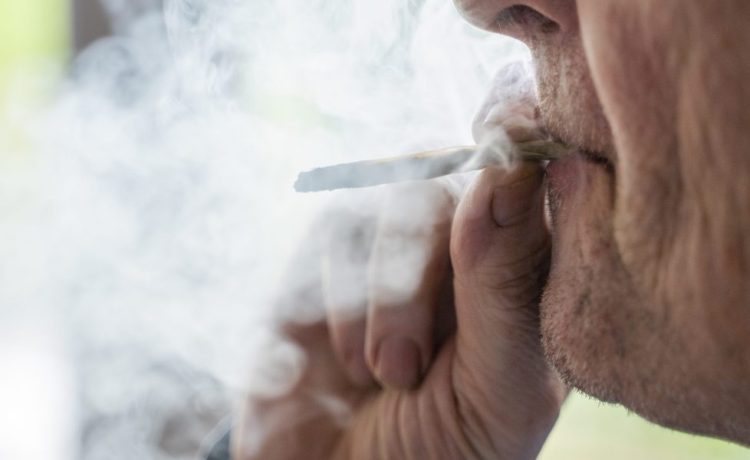
As more states legalize marijuana, older adults are increasingly turning to cannabis to alleviate a host of physical and mental health symptoms. Greater access to marijuana has resulted in record numbers of children visiting the emergency room due to accidental consumption. Now, a new study finds older adults are also facing similar consequences.
In California, cannabis-related emergency department visits for those 65 and over relatively increased by 1,804% between 2005 and 2019.
The study, published in the Journal of the American Geriatrics Society earlier this month, used data from the Department of Healthcare Access and Information. Within the roughly 15-year timespan, cannabis-related emergency room visits rose from 366 visits in 2005 to over 12,000 visits in 2019. These visits were categorized into cannabis abuse and unspecified use, cannabis dependence, and poisoning by cannabis.
Older men had a higher emergency department visit rate in 2019 compared to women, albeit women faced a larger overall visit increase rate over the 15 years, according to the study.
Older Black adults faced the highest increase in cannabis-related emergency department visits compared to those of other races or ethnicities. The authors note that there is limited research on older Black adults and the particular risk factors associated with the increase in cannabis-related emergencies and point to a need for studies to focus on this in the future.
Why is there an increase in cannabis-related hospital visits for older adults?
The increase in emergency department visits resulted from the larger uptick in marijuana use following state legalizations (California legalized recreational marijuana use in 2016) and a decrease in the stigma associated with the drug. A 2022 study from Pew Research Center found that nearly 90% of Americans believe marijuana should be legal for medical or recreational purposes or for medical purposes only. The emergency department visits rose most dramatically between 2013 and 2017, so the legalization of recreational marijuana doesn’t seem to have impacted the number of hospital visits in the state.
Older adults may use cannabis for medical purposes and to relieve many symptoms including pain, sleep troubles, muscle stiffness, agitation, and anxiety and depression. A 2020 study found 61% of older adults who used cannabis began as older adults, and this group was more likely to do so for medical reasons.
“I expect cannabis usage had increased to manage pain because it is yet another option that may work to alleviate pain and now that it is legal for medical and recreational purposes in many states, older adults feel like this is another option to try,” says Dr. Alison Moore, author of the study and chief of the Division of Geriatrics, Gerontology, and Palliative Care in the Department of Medicine at UC San Diego School of Medicine. “Though the evidence of cannabis’ ability to reduce pain is limited, there is some data that it might work so older adults are trying it.”
One study from 2015 found “moderate-quality evidence” that cannabis reduces chronic pain symptoms and muscle stiffness, while another from 2017 concludes there is “limited evidence” that cannabis alleviates neuropathic pain. Cannabis use is also associated with complications that can cause problems with memory, reaction time, and stability, which can increase a person’s fall risk. Older adults are more likely to be on other medications, and drug interactions could also pose an issue.
Educating older adults on cannabis use
More education on the dangers of cannabis use in older adults who can face more dire health complications from the substance is needed, the authors say in the study.
“I do see a lot of older adults who are overly confident, saying they know how to handle it—yet as they have gotten older, their bodies are more sensitive, and the concentrations are very different from what they may have tried when they were younger,” says Dr. Benjamin Han, author of the study and a geriatrician in the Division of Geriatrics, Gerontology, and Palliative Care in the Department of Medicine at UC San Diego School of Medicine, in a press release.
The study authors say healthcare officials should make older adults aware of some of the potentially harmful consequences of cannabis use and normalize conversations around the more widely used drug.
“We know from work in alcohol that older adults are more likely to make a change in substance use if they see that it is linked to an undesirable medical symptom or outcome—so linking cannabis use similarly could help with behavioral change,” Moore says in the press release.
Many substance use questionnaires combine marijuana use with other non-legal drugs, Moore says in the release, which can make older adults more wary of being upfront about their mairjuana usage. Separating out cannabis use into its own category and exploring how it may benefit an older adult, while also assessing risk, is the crucial next step.
“Providers can then ask how frequently cannabis is used, for what purpose—such as medically for pain, sleep, or anxiety or recreationally to relax—in what form (smoked, eaten, applied topically) and if they know how much THC and CBD it contains. Once the provider has this type of information, they can then educate the patient about potential risks of use,” Moore says in the press release.
Learn how to navigate and strengthen trust in your business with The Trust Factor, a weekly newsletter examining what leaders need to succeed. Sign up here.







